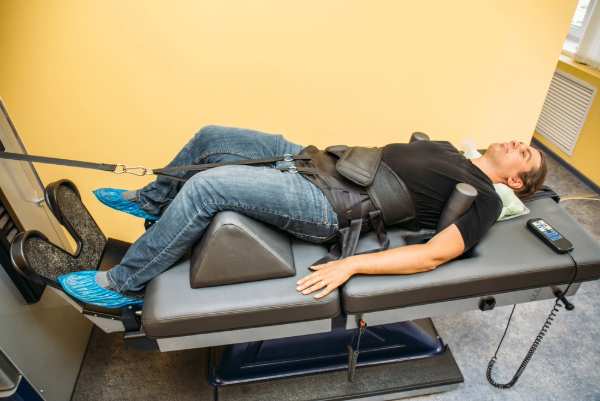Back pain can be debilitating. It can limit mobility, disrupt sleep, and reduce the quality of life. Spine decompression offers a ray of hope. It’s a non-surgical treatment designed to alleviate back pain and improve spinal health. But what exactly is spine decompression? How does it work? And most importantly, what are the benefits of decompressing your spine? This article aims to answer these questions. We’ll delve into the science behind spine decompression, explore its benefits, and address common queries.
Whether you’re a healthcare professional, a patient considering this treatment, or simply curious, this article is for you.
Let’s unlock the health benefits of spine decompression together.
How Does Spine Decompression Work?
Spinal decompression utilizes controlled tension (pull) to stretch the spine. This process is essential for modifying the spinal structure safely.
As the spine is stretched, pressure on discs is reduced. Discs then may absorb nutrients better, helping them heal and regain function.
The therapy commonly uses a decompression table. This table manages the stretch with computer precision, ensuring optimal treatment.
Spinal Decompression Table Benefits
The main benefits of spinal decompression are neck and back pain, disc herniations, nerve damage, numbness, and headaches. One main benefit is that it offers a non-surgical way to treat issues like herniated discs and sciatica. These tables gently stretch the spine. This can reduce pressure on the discs and nerves, which helps relieve pain.
The use of these tables can promote improved spinal alignment and function. This treatment can help reduce pain. Patients also say they can move better and have more flexibility after using a spinal decompression table.
Key Steps in Spine Decompression
- Initial Assessment: A thorough evaluation of spine condition.
- Setup: Patient lies on a decompression table.
- Gradual Stretching: Computer-controlled traction adjusts spinal pressure.
- Relaxation Periods: Intervals allowing muscular relaxation.
Spinal decompression works by creating negative pressure within spinal discs. This pressure change can encourage disc retraction.
This method often results in reduced nerve pressure. Patients typically notice a decrease in pain, improved mobility, and long-term benefits.
Key Benefits of Decompressing the Spine
Decompressing the spine can provide many health benefits, not just pain relief. Let’s look at what benefits of decompressing spine can do.
One main benefit is pain relief. Many people feel less back pain after starting treatment. Decompression helps reduce pressure on the spine, which helps with bulging and herniated discs. This relief also eases nerve pain. It increases the flow of nutrients and oxygen to the discs, which helps them heal. Better circulation helps recovery and lowers inflammation.
Spinal decompression is a safe, non-surgical treatment, making it a good choice over back surgery, which has more risks. The therapy supports spinal health and mobility for the long term. Over time, patients often notice better flexibility and posture.
Spinal decompression therapy can also work well with other treatments, like physical therapy and exercises. It is effective for common spine problems, such as sciatica and spinal stenosis. By reducing pressure, symptoms usually get better.
Summarizing Benefits
- Reduces back and nerve pain.
- Supports disc retraction and healing.
- Enhances nutrient and oxygen flow.
- Offers a non-surgical alternative.
- Improves long-term mobility.
Spinal decompression can delay or prevent the need for more invasive procedures. It sustains spinal health with regular sessions.
Treating Herniated Discs
Herniated discs can cause significant discomfort. Spinal decompression creates a negative pressure to retract disc material. This retraction alleviates pressure on nerves and tissues. Pain associated with these disc conditions often lessens over time.
The therapy supports realignment and healing. It gradually restores proper disc positioning. Decompression therapy is a targeted approach. By addressing the root cause, symptoms are effectively managed.
Does spinal decompression work for bulging discs
Spinal decompression therapy is a treatment for people with bulging discs in their spine. This therapy helps reduce pressure on the discs and nerves. It works by gently stretching the spine to create more space between the bones. This may help the bulging disc move back to its place and reduce pain. Many people have seen good results from this therapy, but it may not work the same for everyone. It’s important to talk to a healthcare professional for a full check-up and advice on treatment options for bulging discs.
Non-Surgical Treatment Option
- Surgery often carries significant risks and recovery time.
- Spinal decompression offers a safer, less invasive solution.
- The therapy avoids surgical complications, making it a preferred choice for many with spinal issues.
- No cutting or injections are involved, offering patients a natural approach to healing.
- Decompression therapy requires no downtime. Patients can typically continue daily activities without interruption.
Long-Term Health and Mobility
Spinal health is crucial for overall well-being. Decompression helps maintain spinal structure and mobility over time.
Regular sessions may prevent future issues. By addressing minor problems early, major complications can be avoided.
Improved spinal alignment aids in posture. Good posture can reduce strain and prevent additional injuries.
Maintaining spinal health supports longevity and quality of life. By investing in therapy, patients often enjoy lasting benefits.
Does decompression help herniated disc?
Decompression can be beneficial for individuals suffering from a herniated disc. When a disc in the spine herniates, it means that the soft inner material has pushed through the tougher outer layer. This can lead to pressure on nearby nerves, which often causes pain, numbness, or weakness in the back and limbs. Decompression therapy aims to relieve that pressure by gently stretching the spine. This process can create more space between the discs, potentially alleviating the symptoms associated with the herniated disc.
Contraindications and Considerations
Not everyone should undergo spinal decompression therapy. Certain health conditions may exclude patients from treatment.
Pregnancy is a contraindication due to potential risks or patients with severe osteoporosis should also avoid this therapy. Those with certain cancers might not qualify.
Always discuss medical history with a healthcare provider. Other considerations include a history of spinal fusion or metal implants. These factors influence the appropriateness of decompression therapy.
Understanding potential risks ensures informed decision-making.
Decompression Therapy: What to Expect
Embarking on spinal decompression therapy? First, understand the process. Treatments typically last 20 to 30 minutes. Sessions are scheduled several times a week over four to six weeks.
During treatment, you’ll lie comfortably on a table. The aim is to relieve disc pressure gently. Here’s what the process involves:
- Lying on a specially designed table
- Experiencing gentle stretching of the spine
- Feeling the realignment of spinal discs
Patients may experience mild discomfort initially. This often subsides as the body adjusts. Communication with your therapist is crucial to optimize comfort.
The Role of Decompression Tables
Decompression tables are important in therapy. They are controlled by computers and can be adjusted easily. These tables provide precise spinal traction.
By adjusting the force, they keep you safe. The tables help stretch slowly, which reduces pressure. This technology helps with healing.
They are designed for comfort and effectiveness, improving treatment success. Skilled operators set the adjustments. This means the treatment is personalized for you.
Treatment Plan and Sessions
A good treatment plan is important for success. Each plan is different based on individual needs. Usually, patients attend several sessions over a few weeks to few months.
In these sessions, the traction force increases gradually. This helps to provide relief while reducing risks. Regular check-ups make sure the treatment is working well.
Changes can be made based on how the patient is doing. Following the schedule is very important. Being committed helps with long-term benefits and promotes healing.
Combining with Other Therapies
Spinal decompression therapy usually works well with other treatments. It is often used with chiropractic therapy or exercise. This complete approach can improve results.
Using heat or cold therapy can help recovery. Electrical stimulation can also help relax muscles. Eating well and staying hydrated are important for good health.
By mixing different therapies, patients may heal faster. Treatment plans can be tailored to fit each person’s needs. Together, these methods can lead to better outcomes.
Success Rates and Patient Satisfaction
Spine decompression therapy is successful for many people. Many studies show that patients feel happy with the results. They often say they feel less pain and enjoy life more.
People like this therapy because it is non-invasive. Many choose it instead of surgery because it has fewer risks. This option helps them recover faster and have less time off.
Patients usually talk about feeling relief right away. Some see improvement over several sessions. Overall, good results lead to a positive view of the therapy.
Patients also appreciate the tailored treatment plans. Each plan is made to fit individual needs. This personalization is important for success.
Final Thoughts on Spine Decompression
Spine decompression offers a viable solution for chronic back pain. Its non-surgical approach makes it accessible to many. As a part of a comprehensive treatment plan, it can significantly improve spinal health.
Considering it as an option could delay or even prevent surgery. By promoting natural healing, it supports long-term well-being. Always consult with a healthcare provider to ensure it’s the right fit for you.




